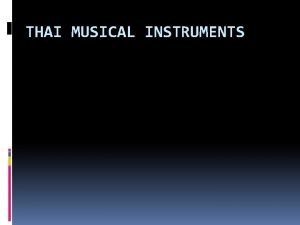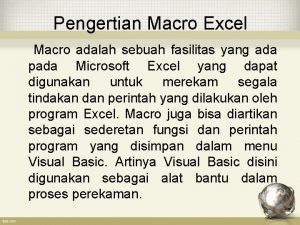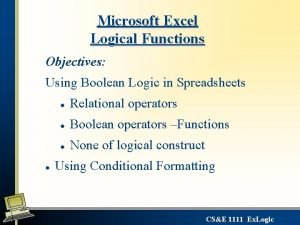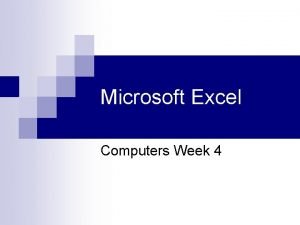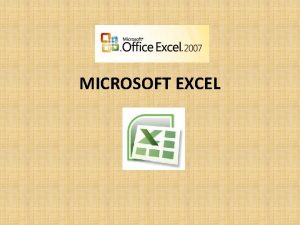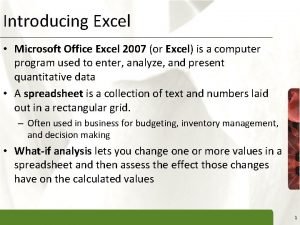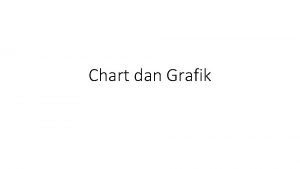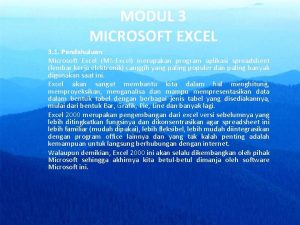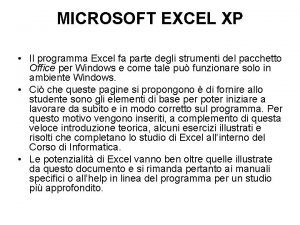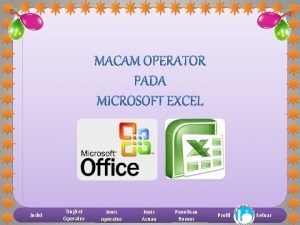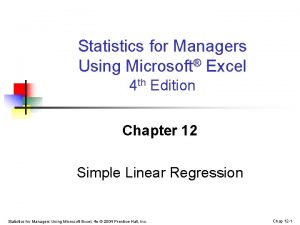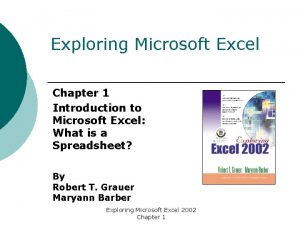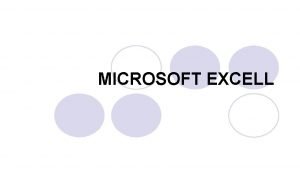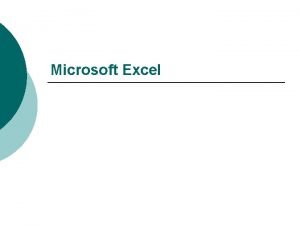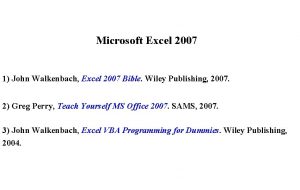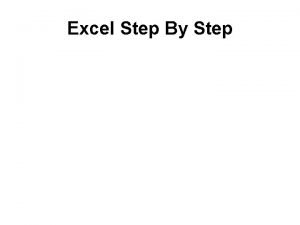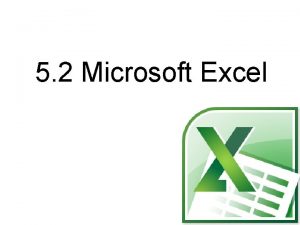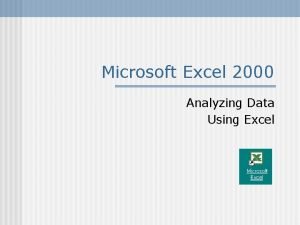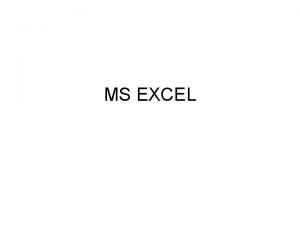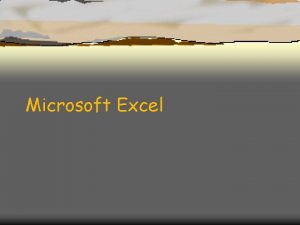DAY 5 MICROSOFT EXCEL Navya Thum navya thummail


















































- Slides: 50

DAY 5: MICROSOFT EXCEL Navya Thum navya. thum@mail. wvu. edu February 06, 2013

ATTENDANCE • Go to https: //cs 101. wvu. edu/tools/recordattendance/ to record attendance. • Enter your My. ID username and password. 12/24/2021 2

CHART • A chart is a graphic or visual representation of data • Multiple chart types can enhance information, adding visual appeal and making it easy to analyze data Excel Chapter 5 12/24/2021 3

CHART COMPONENTS • Data Points - A data point is a numeric value that describes a single value on a chart. • Data Series - A data series is a group of related data points. • Category Labels - A category label is text that describes a collection of data points in a chart. Excel Chapter 5 12/24/2021 4

CHART COMPONENTS Excel Chapter 5 12/24/2021 5

CHOOSING A CHART TYPE • Select the type of chart that best presents your message • When comparing data from multiple series use Column, Bar, Line or Scatter chart • When comparing data of single series to whole use Pie chart or Doughnut chart • Add enhancements to make charts self informative Excel Chapter 5 12/24/2021 6

COLUMN CHARTS • A column chart displays data vertically, with each data series forming a column Excel Chapter 5 12/24/2021 7

CLUSTERED COLUMN CHART Excel Chapter 5 12/24/2021 8

REVERSING CATEGORIES AND DATA SERIES Excel Chapter 5 12/24/2021 9

STACKED COLUMN CHART Excel Chapter 5 12/24/2021 10

CLUSTERED VS. STACKED • A multiple data series chart compares two or more sets of data – Clustered column chart • Groups similar data in columns • Makes visual comparison easier – Stacked column chart • Places (stacks) data in one column with each data series in a different color for each category Excel Chapter 5 12/24/2021 11

100% STACKED COLUMN CHART Excel Chapter 5 12/24/2021 12

3 -D COLUMN CHART Excel Chapter 5 12/24/2021 13

BAR CHART Excel Chapter 5 12/24/2021 14

LINE CHART Excel Chapter 5 12/24/2021 15

PIE CHART Excel Chapter 5 12/24/2021 16

AREA CHART Excel Chapter 5 12/24/2021 17

X Y (SCATTER) CHART Excel Chapter 5 12/24/2021 18

DOUGHNUT CHART Excel Chapter 5 12/24/2021 19

BUBBLE CHART Excel Chapter 5 12/24/2021 20

CREATING A CHART • Select the data. • Go to Insert ribbon -> Charts group -> Select the appropriate chart 21

MOVING A CHART • To move a chart: – Click the Design tab – Click Move Chart under the Location group Excel Chapter 5 (contd. . ) 12/24/2021 22

CHANGING THE CHART TYPE • Using the Chart Tools contextual tab: – Click the Design tab – Click Change Chart Type – Select the desired chart type Excel Chapter 5 (contd. . ) 12/24/2021 23

CHANGING THE DATA SOURCE Excel Chapter 5 (contd. . ) 12/24/2021 24

PRINTING A CHART • To print an embedded chart: – Select the chart – Click the File tab – Click Print to display the Backstage view – Use the Print Selected Chart option • To print a chart sheet: – Use the Print Active Sheet option Excel Chapter 5 (contd. . ) 12/24/2021 25

CHART LAYOUT • The Layout tab offers many ways to enhance a chart visually by selecting specific chart elements, inserting objects, displaying or removing chart elements, customizing the axes and formatting background. Excel Chapter 5 (contd. . ) 12/24/2021 26

FORMATTING CHART ELEMENTS • Formatting a chart element: – Right-click the element and select the Format element command – The element portion will change depending on the selection Excel Chapter 5 (contd. . ) 12/24/2021 27

CUSTOMIZING CHART LABELS • A chart title is the label that describes the entire chart • An axis title is a label that describes either the category or value axis • A legend is used to distinguish data points in a pie chart or data series in a multiple series chart • A data label is the value or name of a data point Excel Chapter 5 (contd. . ) 12/24/2021 28

AXES AND GRIDLINES • Based on the data source values, Excel computes starting, ending, and incremental values for display on the value axis. • A gridline is a horizontal or vertical line through the plot area. Excel Chapter 5 (contd. . ) 12/24/2021 29

ADDING A TRENDLINE • A trendline is a line used to depict trends and forecast future data. Excel Chapter 5 (contd. . ) 12/24/2021 30

TRENDLINES • Trend Types – Linear – Exponential – Logarithmic – Polynomial – Power etc. , . • Forecast • R-Squared Value Excel Chapter 5 (contd. . ) 12/24/2021 31

CREATING A SPARKLINE • A Sparkline is a miniature chart displayed in a single cell • To create a sparkline ― Click the Insert Tab ― Click Line, Column, or Win/Loss in the Sparklines group. Excel Chapter 5 (contd. . ) 12/24/2021 32

CREATE A PIVOTTABLE • A Pivot. Table allows you to summarize, analyze, and explore large amounts of data • Data can be dynamically arranged to view it from different angles • One column must have duplicate values to create categories for organizing and summarizing data • Another column must have numeric values • Create a Pivot. Table by clicking Pivot. Table in the Tables group on the Insert tab 33 12/24/2021

CREATE A PIVOTTABLE 34 12/24/2021

CREATE A PIVOTTABLE 35 12/24/2021

CREATE A PIVOTTABLE 36 12/24/2021

CHANGE THE VALUES FIELD • Select the function used to calculate summary statistics • Default is: – Sum for values – Count for text fields • Specify a custom column heading • Apply number formatting 37 12/24/2021

CHANGE THE VALUES FIELD 38 12/24/2021

MODIFY A PIVOTTABLE • Add, remove, or rearrange fields to get a different perspective of the data • Be careful not to make the data overwhelming with too many details • Excel does not automatically update Pivot. Tables 39 12/24/2021

SORT, FILTER, AND SLICE A PIVOTTABLE • Sort data in a Pivot. Table – Default is alphabetical by row label text • To quickly rearrange data, click in a cell in the column you want to sort, and then click Sort Smallest to Largest (Sort A to Z for text) or Sort Largest to Smallest (Sort Z to A for text) in the Sort & Filter group on the Options tab • For specialized sorting, click Sort in the Sort & Filter group on the Options tab – If you click in a row label or column label first, you get a dialog box that has slightly different options than if you click on a value first 40 12/24/2021

SORT, FILTER, AND SLICE A PIVOTTABLE 41 12/24/2021

SORT, FILTER, AND SLICE A PIVOTTABLE 42 12/24/2021

SORT, FILTER, AND SLICE A PIVOTTABLE • Apply filters to show a subset of data in a Pivot. Table • Two types of filters: – A report filter sets the overall conditions for aggregating data – A group filters out data based on a row or column category • Filter by one or multiple items, as well as by entering a search condition 43 12/24/2021

SORT, FILTER, AND SLICE A PIVOTTABLE 44 12/24/2021

SORT, FILTER, AND SLICE A PIVOTTABLE 45 12/24/2021

FORMAT A PIVOTTABLE • Basic formatting applied to Pivot. Tables: – Primary row labels formatted in bold – Subtotals are bold • Use Pivot. Table Tools Design tab to apply a Pivot. Table style and control: – Font color – Fill color – Bolding – Border lines 46 12/24/2021

FORMAT A PIVOTTABLE 47 12/24/2021

CREATE A PIVOTCHART • A Pivot. Chart is a graphical representation of data in a Pivot. Table. • You can create a Pivot. Chart from a Pivot. Table or at the same time you create a Pivot. Table. • Creating and customizing Pivot. Charts is similar to the methods used on regular charts. • A Pivot. Chart is interactive, meaning changes made in the associated Pivot. Table are immediately reflected in the Pivot. Chart. 48 12/24/2021

REMINDER • Homework #1 is due on 02/08/13 by 11: 59 P. M • My. ITLab Lesson B due on 02/11/13 by 11: 59 P. M 12/24/2021 49

Questions? 50 12/24/2021
 Navya venkateshaiah
Navya venkateshaiah Ranat ek lek classification
Ranat ek lek classification Day 1 day 2 day 3 day 4
Day 1 day 2 day 3 day 4 Microsoft official academic course microsoft excel 2016
Microsoft official academic course microsoft excel 2016 Microsoft excel
Microsoft excel Day 1 day 2 day 817
Day 1 day 2 day 817 El software utilitario microsoft excel es:
El software utilitario microsoft excel es: Excel macro adalah
Excel macro adalah Pengenalan ms excel
Pengenalan ms excel Excel boolean logic
Excel boolean logic Excel spreadsheet vocabulary
Excel spreadsheet vocabulary Pengenalan microsoft excel
Pengenalan microsoft excel Deretan menu untuk menjalankan sebuah perintah disebut
Deretan menu untuk menjalankan sebuah perintah disebut Yang bukan kegunaan program pengolahan angka adalah
Yang bukan kegunaan program pengolahan angka adalah Excel for xp
Excel for xp Exploring microsoft office excel 2016 comprehensive
Exploring microsoft office excel 2016 comprehensive Excel lesson 4 vocabulary
Excel lesson 4 vocabulary Excel 2010 training
Excel 2010 training Solver excel 2007
Solver excel 2007 Chart/ grafik terdapat pada menu:
Chart/ grafik terdapat pada menu: Microsoft excel referat
Microsoft excel referat Modul microsoft excel
Modul microsoft excel Jelaskan kegunaan microsoft excel dalam bidang akuntansi
Jelaskan kegunaan microsoft excel dalam bidang akuntansi Excel xp
Excel xp Apa yang dimaksud operator acuan
Apa yang dimaksud operator acuan Fungsi menu dan ikon pada microsoft excel
Fungsi menu dan ikon pada microsoft excel Uraikan tentang efektivitas rumus pada microsoft excel 2013
Uraikan tentang efektivitas rumus pada microsoft excel 2013 Durbin watson test in excel
Durbin watson test in excel Apa kegunaan operator rasional pada microsoft excel
Apa kegunaan operator rasional pada microsoft excel Apa kegunaan operator rasional pada microsoft excel
Apa kegunaan operator rasional pada microsoft excel Microsoft excel error
Microsoft excel error Excel chapter 1
Excel chapter 1 What is an unqualified structured reference in excel
What is an unqualified structured reference in excel Microsoft office excel merupakan aplikasi pengolah
Microsoft office excel merupakan aplikasi pengolah Microsoft excel
Microsoft excel Microsoft excel 2016 basics vocabulary
Microsoft excel 2016 basics vocabulary Microsoft excel program
Microsoft excel program John walkenbach
John walkenbach Microsoft excel environment with label
Microsoft excel environment with label Microsoft official academic course microsoft word 2016
Microsoft official academic course microsoft word 2016 Microsoft microsoft startwarren theverge
Microsoft microsoft startwarren theverge Microsoft official academic course microsoft word 2016
Microsoft official academic course microsoft word 2016 Pgcps calendar a day b day
Pgcps calendar a day b day Oceans apart day after day meaning
Oceans apart day after day meaning Day to day maintenance
Day to day maintenance As your room gets messier day by day, entropy is
As your room gets messier day by day, entropy is I don't know about tomorrow i just live from day to day
I don't know about tomorrow i just live from day to day Act 2, scene 4 romeo and juliet summary
Act 2, scene 4 romeo and juliet summary Growing day by day
Growing day by day Observation of seed germination day by day
Observation of seed germination day by day Germination conclusion
Germination conclusion

